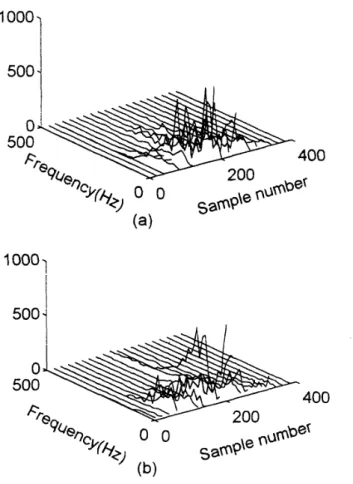Using Time-Frequency Analysis Technique in the
Classification of Surface
EMG
Signals
Gwo-Ching Jang, Cheng-Kung Cheng', Jin-Shin L,ai**, and Te-Son I<uo
Department of Electrical Engineering, *Center
for
Biomedical
Engineering. and **Department of Rehabilitation, National Taiwan
University,
R.
0.
C.
Abstract
A time-frequency analysis technique with Wigner-Ville distribution was developed for discriminating a set of up- per limb motions using just one channel surface EMG sig- nals. EMG d a t a were obtained from the distal portion of the deltoid. T h e limb motions included elbow exten- sion/flexion. wrist pronationfsupination. and wrist abduc- tion/adduct.iion. T h e 'LD cross-correlation was employed for classification of the upper limb functions.
Introduction
Electromyographic (EMG) signals from body's intac-
t musculature have been suggested and utilized by many researchers as various trigger commands for a multifunc- tion lower arm prosthesis[l][2]. The goal of this research is to deal with the pattern recognition of EMG signals using time-frequency analysis technique to generate con- trol commands for prosthetic devices. .A single channel
EMG signals were measured from the distal portion of the deltoid to discriminate six limb motions included elbow extensionfflexion, wrist pronationfsupination, and wrist abduction/adduction[3].
The spectral characteristics of the ESIG signals con- cerning with different contractions of the same muscle is different [2]. This phenomenon implied that discrimina- tory information was contained in the difference between the spectral characteristics varieties for different muscle activation patterns a t the same muscle site. The time- frequency analysis is to describe situations where the fre- quency content of asignal is changing in time. T h e classifi- cation technique based on time-frequency analysis has the greater potential for formation of the feature vector which is afforded by the 2D nature of representations[4]. In this paper, EMG pattern recognition using time-frequency analysis based on Wigner-Ville distribution (WVD) was
considered.
classification of the upper limb motions.
The 2D cross-correlation was employed for
Methods
Wigner-Ville DistributionThe time-frequency representation of IVVD provided high resolution signal characterization in a time-frequency space, and good noise rejection performance
[4].
The real- valued, discrete WVD representation is defined as followwhere
k,l
are the time-index and the frequency-index, re- spectively, and the length of interest signals is ,V = 'LI<+l.EMG Processing
Twenty sets of
EMG
data were recorded from distal portion of deltoid. A preamplifier with a bandpass filter between lOHz and lkHz was used to reduce the effects of high frequency noise and motion artifact. The analog-te digital converter,
having 12-bit resolution, was used to sample the amplifiedEMG
signals at 2kHz. The time- frequency analysis was applied with WVD to generate 2D feature vectors. In order to reduce the wide dynamic range of WVD of EMG signals, the logarithmic compres- sion scheme was employed. The feature vector was nor- malized with respect to its root-mean-square valus. The 2D cross-correlation method w a s used to classify the upper limb motions. All the computing operations were comput- ered by the Texas Instruments TSlS320C30 floating-point digital signal processor.0-7803-2050-6/94 $4.00 01994 IEEE
1242
Results and Discussions
Wrist Pronation
Elbow Extenstion
The WVD of EMG signals for wrist abduction and ad- duction movement is shown in Fig. 1. Note t h a t the time- frequency distribution is defferent as wrist abduction and adduction in the Fig. 1. Based on this difference between the spectral characteristics varieties, the limb motions can be classify. T h e preliminary discrimination rate results derived from 2D cross-correlation technique is shown in Table I. These recognition rates show that. the WVD per- forms well in generating control commands for prosthetic devices. This time-frequency analysis technique can also be used in studying muscle fatigue in the future.
90%
70%.
References
[l]. Graupe
D..
Salahi J . , Zhang D.:“Stochastic Analy- sis of Myoelectric Temporal Signatures for Multifunction- al Single-Site Activation of Prostheses and Orthoses,”J Biomed. Eng., 7: 18-29:1985.[2]. Doerschuk PC.! Gustafson DE., \Yillsky AS., “Upper Extremity Limb Function Discrimination Us- ing EMG Signal Ana1ysis:”IEEE Trans. Biomed. Eng., 30118-28, 1983.
[3]. Michael F. Kelly, Philip A . Parker, and Robert
N.
Scott,“ hlyoelectric Signal Analysis Using Neural Set- warks,’: IEEE Eng. Medicine & Biology Mag., pp. 61-64,March 1990.
Boualem R . and Peter O . , “ A Methodology for Detection and Classification of Some Underwater A- coustic Signals Using Time-Frequency Analysis Tech- niques,”IEEE Trans. Acoust. Speech Signal Processing, vol. 38. no. 11, pp. 1829-1841, Nov. 1990.
[4!.
Table 1. The recognition rate for six limb motions
I
Wrist SupinationI
9596I
Elbow Flex ion
Wrist Abduction
Wrist Adduction
’OO0l
I500
i
Figure 1. The WVD of EMG signals for (a) wrist abduction (b) wrist adduction
